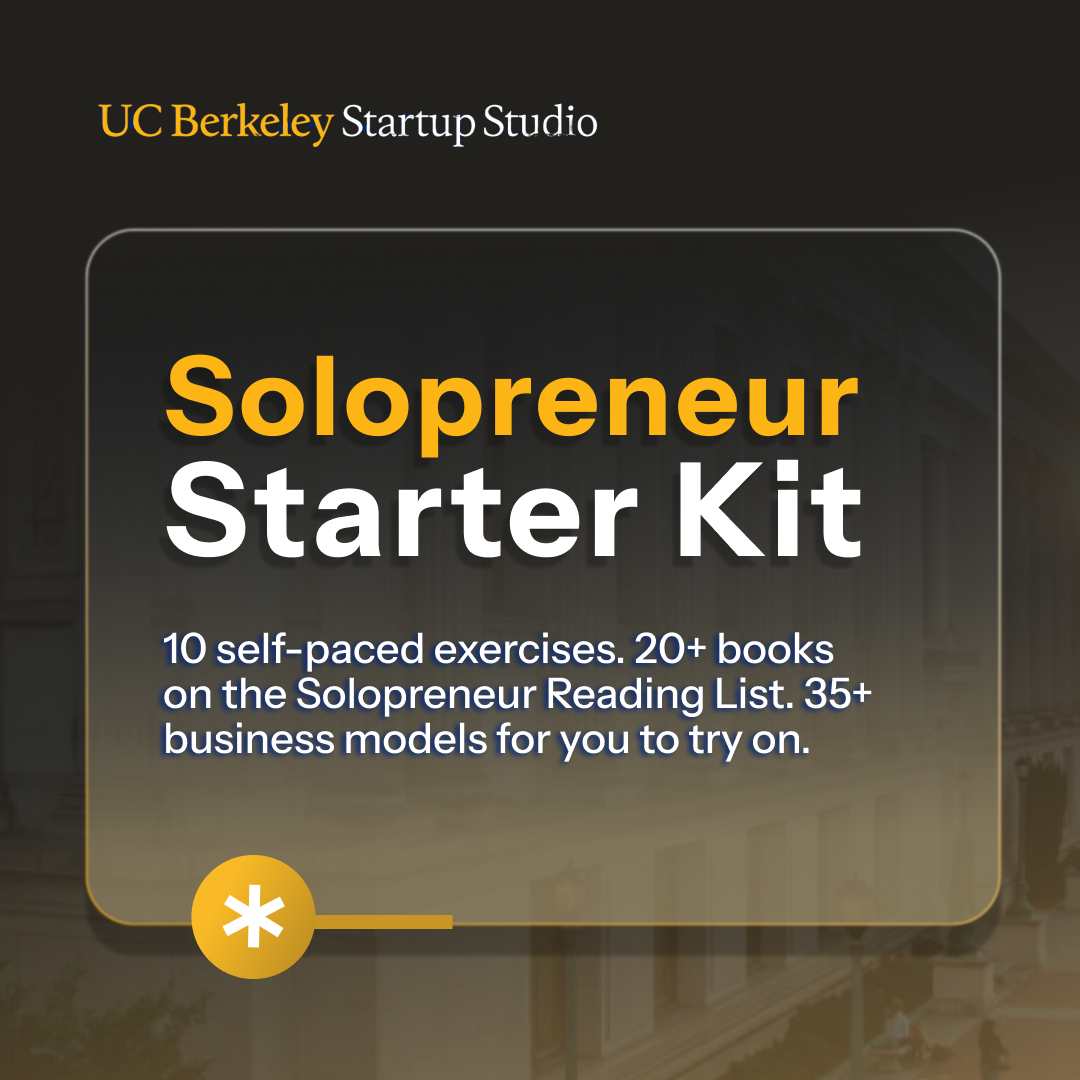Solopreneur Starter Kit
"When you bet on yourself, you become the main character in your story and the master of your destiny. You become invincible in the market and fearless in the world.
You can make a living on your own terms. Connect your passions, proficiencies, and past experiences to profit from your labor of love.
No matter where you are on the employee-to-entrepreneur spectrum, you can own your life and live your “hell yes” lifestyle.
That is the path of the solopreneur.
Welcome to the journey."

Luke Kim
Teacher & Course Creator,
UC Berkeley Sutardja Center for Entrepreneurship & Technology (SCET)
Curious about the UC Berkeley Solopreneur Course? Get access here and use STARTUPSTUDIO for 10% off. The Berkeley Method of Entrepreneurship (BMoE) is a hands-on approach based on experiential education. Previously, this award-winning instruction was only available to Berkeley students and executives. Now, you can discover the secrets of BMoE from anywhere in the world.
ENTREPRENEURSHIP VS. EMPLOYMENT
If you have what it takes to get a good job and keep it, you have what it takes to build a hustle and monetize it, whether it’s a side hustle or a venture-backed startup.
For your employer, the rule of thumb is that you should be worth 3x your own salary or you’re dead weight. If you have a boss, you're one executive decision (or emotional whim) from losing your livelihood. A happy customer will refer you more business but a happy boss will keep you and require a non-compete.
Think about it.
Entrepreneurship is easier than employment
Are you more confident about finding the right employer, appealing to them, and surviving without getting booted for a year or more? Or are you more confident about landing one customer and impressing them, helping with something that fits your passion and proficiency?
Entrepreneurship and employment are not mutually exclusive. But one will be your primary identity and the other will be a secondary quality. Be intentional about how you introduce yourself to others and how you think about yourself.
Next time someone asks "What do you do?" try answering as an entrepreneur instead of an employee. You may be surprised by the way your interactions get more genuine.
Resist the urge to say "I am [job] at [company]" or "I've been at [organization] for [years]." This is how a non-player character (NPC) answers the question.
Instead, say —
- "I help [customer type] with [problem type]"
- "I'm looking into [topic] because [curiosity]"
- "I'm working on [idea] to address [market opportunity]"
- "My intention is [goal] and I seek [skill/experience] collaborators"
START WITH SELF-AWARENESS
Your everyday skills and experiences are more valuable than you realize. Be kind to yourself and open-minded about your potential.
Remember, "perfect is the opposite of good." It's a common saying among solopreneurs. For us, speed is a top priority and analysis paralysis is untenable.
If you want to go far, go together. If you want to go fast, go alone. As a solopreneur, you advance alone because you need agency and self-sovereignty.
CURIOSITY, PRIDE, BELONGING
When you feel curiosity, pride, and belonging in your life, that's a clue. It's a signal about where you'd shine brightest and be most fulfilled. Starting a business means you are your own boss and employee.
Your well-being is directly correlated with the success of your business. Founders screw themselves when they lack self-awareness. When you get stuck, it's like sprinting on a hamster wheel. Most people know themselves as an employee, but not as an entrepreneur - not yet. By knowing yourself, you prevent false starts and setbacks
For example:
- building a business that you serve instead of a business that serves you
- doing too much, offering the world, and trying to be everything for everybody
- walking into a self-made trap, forcing business outcomes with fake enthusiasm
- creating something with no demand, wondering why nobody loves your baby
- failing close to success because you lose steam and leave resources unactivated
What brought you a sense of curiosity, pride, and belonging?
Think about the last time you truly felt these things. Anyone can wrap a basic pitch around their skill set and try to sell, but it takes inner work to genuinely align your passions and proficiencies
MAP YOUR PAST TO PLOT YOUR FUTURE
Have you ever mapped your past?
It's not a professional résumé or a list of past jobs. It's a holistic view of yourself, from your smallest personal hobbies to your proudest accomplishments.
Many of you construct your personal story, professional persona, and résumé in order to find better employment and to look respectable in the eyes of society.
When you construct a map of your life in order to find business opportunities for yourself, you’re choosing to view your past as a goldmine of future opportunity.
How can you become the most profitable and marketable version of yourself?
FOUNDER-MARKET-FIT & FOUNDER-PROBLEM-FIT
Founder-market-fit is the alignment between your lived experiences and specific markets, industries, localities, communities, etc. This gives you an unfair advantage.
For example, a retired trial lawyer has founder-market-fit for a coaching business that sells to young partners of busy litigation firms who suffer from unique personal and professional issues due to the intensity of building a trial-winning law firm.
Founder-problem-fit is the idea that every solopreneur or entrepreneur can empathize with a subset of customer personas based on their lived experiences.
For example, a hobbyist who raises exotic fish understands how hard it is to learn about this niche, to care for rare species, and to legally trade and transport them around the world. These problems can be solved by publishing an ebook, offering a course, doing 1:1 consultations, providing done-for-you setup, selling kits, etc.
Depending on the way you like to think, you can map your past by
- drawing a mind map
- making a list
- talking to a close friend or mentor while taking notes
Where do you see founder-market-fit and founder-problem fit in your life?

DESIGN A SOLO BUSINESS IDEA
How much money do you actually want to make? This answer affects everything.
How much leisure time do you actually need? Most of us overestimate this.
What can you give up and how long can you suffer to make it happen? Be realistic.
PRODUCTIZE & SYSTEMATIZE YOURSELF
There are many individuals who achieve total freedom of time and location by betting on themselves and achieving mind-blowing profitability. That's the beauty of betting on yourself. There's a million-dollar business model within you, waiting to be discovered.
Consider ideas that leverage your personality and preferences. Optimize for products and services that you've successfully delivered before. Ask yourself:
- What can you talk about at length without any preparation?
- What's an outcome you'd deliver with joy, even if you weren't paid?
- How do you work best (for example - full time or part time, solo or team, on site or remote, extrovert or introvert, multitasking or unitasking, in-field or in-office)?
As you brainstorm, think about problems you've experienced. The more you resonate with a problem, the likelier it is that you'll sell and deliver with empathy. Ask yourself:
- What inefficiencies have you seen in the businesses you've worked with?
- What problems have you experienced in a specific industry or community?
- What's something people hate doing and do poorly, but you don't mind doing?
When you ideate, you combine your experiences and expertise - your knowledge and knowhow - into a venture that's unique to your passions and proficiencies.
Try crafting three ideas by writing a short pitch for each concept.
Include your customer’s pain point, why you’re the right person, and the outcome you promise.
DISCOVER YOUR BEACHHEAD MARKET
Targeting a beachhead market means focusing on a specific customer persona, refining your offer based on feedback, establishing a foundation to iterate. You'll have to make some assumptions and test them in the real world.
Beachhead markets are:
- Addressable: You understand the market and can effectively reach its customers.
- Winnable: You can realistically capture a meaningful share of this market.
- Valuable: The market's large enough to do business and grow.
Business is a cycle of iteration. Test and validate your assumptions based on customer feedback and profitability. Be unafraid to prove your own assumptions wrong. Make small bets and build incrementally. Launch fast, manage risks, and reduce costs.
Your addressable market includes both friends and enemies: partners and competitors. Sometimes, they are one and the same. Often, we can mistake one for the other.
With partners, do business like it's a playground:
- Bundle offers to make a premium upsell or top tier package.
- Become a sales channel and affiliate for each other.
- Share in-kind value and business connections.
With competitors, do business like it's a battlefield:
- Get business intelligence by studying them.
- Target their audience base or social following to take their customers.
- Position yourself in contrast and prove why they are less worthy.
Now that you’ve come up with a few ideas, try looking up three competitors and three potential partners in your beachhead market.
Learn their strengths and weaknesses. Read reviews, study their offers and prices, and incorporate this into your own vision.
TAILOR A BUSINESS MODEL FOR YOU
Designing a business model is like tailoring a suit for yourself.
Unfortunately, there's no Savile Row in business. There are no tailors who can take your preferences and magically create your ideal profitable business. Below is a list of business models. Think of it as a catalog of fabrics, styles, and colors for your suit.
As you can see, no matter your idea, there's a way to become profitable.
Try these business models for size. Try pricing out your business ideas, write them as customer-facing offers, and drafting new pitches based on your evolving thoughts. Keep in mind that there are many more models and every model can be combined.
- Subscription and Membership:
Customers pay a recurring fee for access. - Freemium:
Basic services are free, while premium features require payment. - Leasing:
Renting out a product for a specific period, rather than selling it outright. - Product-as-a-Service:
Offering a product on an ongoing basis, including service. - Managed Services:
Providing ongoing support and maintenance for something. - Software-as-a-Service:
Offering a software solution on a subscription basis. - Productized Service:
Offering a service on a subscription basis.
Note:
Don’t overthink your business model. If you can’t do the math on a napkin, it means you’re doing too much math. Remember that you can always elevate your rates, add new revenue lines, and widen your margins in the future.
YOUR CHAMPIONS & PROSPECTS
Prospects are potential customers.
They fit your customer persona and they exist within your beachhead market.
Champions are allies to your business.
They may be old friends, clients, bosses, and colleagues. They will help you.
Be shameless in your outreach. Lead with pronoia. Assume the best.
SELLING AS A SOLOPRENEUR
Most people overthink sales. If you’re new to solopreneurship, selling can feel as awkward as a high school boy asking a girl out on a date for the first time.
That's why we have thousands of books on this topic and so-called "gurus" on LinkedIn who promise secret techniques to make you instantly rich with zero effort. Ignore them.
HOW TO SELL FROM 0 TO 1
There are only two things you need to think about:
- how to ask the right questions
- how to ask for the right assistance
If this is all you ever do in front of your connections, you'll do well and make money.
Caution: Most people don't feel ready to sell until they reach a significant milestone. Don't make this mistake. Speak with your champions and prospects immediately.
Try building a “short list” of five champions and five prospects within your first or second degree connections.
Check LinkedIn or some other form of contact management.
Call your champions first to get feedback and helpful introductions.
ENGINEERING SERENDIPITY
Engineering serendipity is a skill you can learn.
It’s the act of situating yourself within social interactions that activate interpersonal “clicks” and “aha” moments. If you do it right, you will rally people around you and make them think it’s all their idea. You’re basically performing “Inception.”
RALLY WARM CONTACTS USING SOCIAL CAPITAL
When's the last time you sat with your best friends and old friends?
What about mentors and elders?
It's helpful to connect and (re)connect with these people in moments of transition.
Try picking three people to call or text today. Engineer serendipity and activate these connections. Here's a helpful template that works well, whether you write it or say it:
"Hi [first name], how are you? I'd like to share something new with you. I've been working on a [business descriptor] that combines [passion] and [proficiency]. So far, I've [respectable progress]. Looking to meet [type of contact] and explore [question]. Would you like to hear more and share some advice?"
Most people give up at the idea stage but you're different. There’s no need to be shy when you reach out. At this point, you’ve already done a lot:
- You looked inwards to understand your past life and ideal life.
- You decided to educate yourself and go kinetic.
- You mapped your experiences and expertise.
- You brainstormed new ideas.
- You identified beachhead markets for your ideas.
- You analyzed potential partners and competitors.
- You activated your network and identified your champions.
- You studied business models and tried them on for size.
RAPID FIRE GO-TO-MARKET LESSONS
When a customer's pain is urgent and intense, you can sell faster and charge more.
When a customer's problem is obvious, it's easy to diagnose and address.
An entrepreneur is like a scientist or inventor, testing hypotheses and assumptions.
Customer validation helps you meet their demand or prove yourself wrong.
NEVER expect your customer to meet you where you’re at, or meet you in the middle. YOU need to meet them where they’re at.
Joining a community of your ideal customer persona (ICP) is like going behind enemy lines.
By joining your competitor’s community, gather intelligence and sell from within.
You can accomplish more in 5 minutes of physical contact than you can in 5 emails.
Social events make people nicer and easier to open; they want to feel likable.
Strategic partners help you sell more, sell easier, deliver more, or deliver easier.
Whether it's your contact history on Gmail, your LinkedIn connections, or your friends on Facebook, there are people who get (forced) notifications when you say something.
Building in public v.s. building in private is your personal choice.
Lead magnets funnel prospects into your sales pipeline.
Side project marketing is a lead magnet or a dangerous distraction. Be ROI-driven.
It's better to have others toot your horn rather than showing off about yourself.
Publicity = building or borrowing foot traffic and web traffic.
Never sell to the poor or downtrodden. You’ll have to exploit them to make money.
We don’t make buyer decisions based on moralizing calls-to-action (CTA). Don’t pitch a business as a social impact mission and expect to get customers.
Pitch for curiosity, not information.
Sales = converting the curious by compelling buyer behavior. Compulsion is an emotional response that overrides logic.
Ready to put theory into practice?
Let’s begin.
Zero to Hero Solopreneur LaunchPad is a course that guarantees progress from 0 to 1. Transform into a profitable solopreneur with a cohort of compatriots.
Action is the only thing that separates you from your dream.
A healthy solopreneur business should make $3,000~30,000 per month per project.
Think you can make this happen? Invest in yourself by taking the course. Use the code “STARTUPSTUDIO” for 10% off. All students receive a UC Berkeley College of Engineering Certificate, access to campus resources, a LinkedIn badge, and an alumni network.
COURSE SYLLABUS
- Week 1 - Ideation
How to Optimize for Passion & Profit: Founder-Market-Fit - Week 2 - Business Creation
How to Productize Yourself & Systematize Delivery - Week 3 - Funnels, Lead Magnets, Calls-to-Action
How to Attract Your 1,000 True Fans & First Customer - Week 4 - Automating & Scaling Business Development
Go-to-Market: How to Generate 1,000s of Leads & Automate Outreach - Week 5 - Elevating Rates, Increasing Margins, Building Revenue Lines
How to Systematize Your Quest for Profit By Testing Ideas & Revenue Lines
What People Say

Ali Winkle
CEO at Just Drive Media (Award-Winning Public Relations Firm)
“Luke's energy is infectious and the program was full of actionable recommendations and high quality resources - more than most could get through during the cohort, but available for the future to keep moving with. I highly recommend it!”

Arezu Aghasey
Plug & Play Tech Center | 25x Hackathon Winner | Ex-Deloitte
“Luke is the real deal - he teaches from authentic firsthand experience, focusing on practice over theory. In 30 minutes with Luke, you'll learn more than you would in a semester of business school.”

Bill James
CFA, CMT, FRM, Ex-Investment Director at University of Notre Dame
“Luke has energy, enthusiasm, and passion for helping others! I came away with a ton of actionable items to help me think about, and actually START a business. Luke is a wonderful person to know and I'm so glad I took this course. Highly recommended! He is so positive and supportive of everyone's ideas.”
SOLOPRENEUR READING LIST
BUSINESS & SELF-DEVELOPMENT
Employee to Entrepreneur: Earn Your Freedom and Do Work that Matters by Steve Glaveski
Where Good Ideas Come From: The Natural History of Innovation: Steven Johnson
Range: Why Generalists Triumph in a Specialized World: David Epstein
The Monk and the Riddle: The Art of Creating a Life While Making a Living: Randy Komisar
Getting to Plan B: Breaking Through to a Better Business Model: John Mullins, Randy Komisar
Venture Deals: Be Smarter Than Your Lawyer & VC: Brad Feld, Jason Mendelsohn
Thinking in Bets: Making Smarter Decisions When You Don't Have All the Facts: Annie Duke
Regulatory Hacking: A Playbook for Startups: Evan Burfield
Chaos Monkeys: Obscene Fortune & Random Failure in Silicon Valley: Antonio Garcia Martinez
Never Split the Difference: Negotiating As If Your Life Depended On It: Chris Voss
PHILOSOPHY & SPIRITUALITY
The Pathless Path: Imagining a New Story For Work and Life: Paul Millerd
Outliers: The Story of Success: Malcom Gladwell
The Go-Giver: Bob Burg, John David Mann
Principles for Dealing with a Changing World Order: Why Nations Succeed and Fail: Ray Dalio
The Third Door: The Mindset of Success: Alex Banayan
Bullshit Jobs: A Theory: David Graeber
The Book of Five Rings: Miyamoto Musashi
The 15 Commitments of Conscious Leadership: Bill Burnett
Debt: The First 5,000 Years: David Graeber
How Will You Measure Your Life?: James Allworth, Clayton M. Christensen
